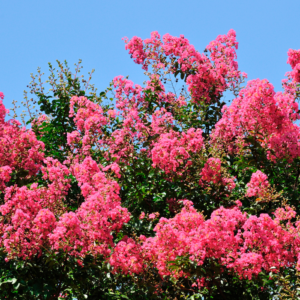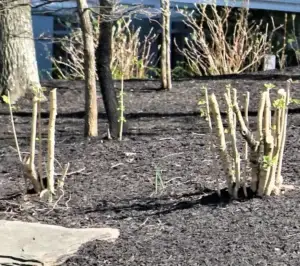 Crape Myrtles are beloved for their vibrant summer blooms and striking bark, making them a popular choice for many homeowners. However, to ensure they remain healthy and beautiful, proper pruning is essential. Pruning Crape Myrtles in late winter or early spring is particularly important for several reasons.
Crape Myrtles are beloved for their vibrant summer blooms and striking bark, making them a popular choice for many homeowners. However, to ensure they remain healthy and beautiful, proper pruning is essential. Pruning Crape Myrtles in late winter or early spring is particularly important for several reasons.
Why Prune in Late Winter/Early Spring?
- Encourages New Growth and Blooms: Crape Myrtles bloom on new growth. Pruning in late winter or early spring, before new growth begins, helps the tree develop strong new shoots and buds that will produce flowers in the upcoming season.
- Maintains Tree Shape: Pruning helps maintain the natural shape of the tree, preventing it from becoming overgrown and unruly. This is especially important for crape myrtles, which can grow quite large if left unchecked.
- Removes Dead or Diseased Wood: Late winter pruning allows you to remove any dead or diseased branches, which can improve the overall health of the tree and reduce the risk of pest infestations.
Best Practices for Pruning
- The Right Tools:
Ensure your crape myrtles receive expert care by using the right tools. Depending on the size of your tree, our team will use clean, sharp hand shears, loppers, or a pruning saw to make precise cuts and promote healthy growth.

- Avoid “Crape Murder”: This term refers to the practice of severely cutting back crape myrtles, which can stress the tree and lead to poor growth. Instead, aim for light, selective pruning to maintain the tree’s natural shape.
- Remove Suckers and Dead Wood: We’ll remove any suckers (new growth from the base of the tree) and dead or crossing branches to enhance air circulation and sunlight penetration, both of which are crucial for the healthy growth of your crape myrtles.
Common Diseases of Crape Myrtles
Crape myrtles are relatively hardy, but they can still fall victim to several common diseases. Here are some to watch out for:
- Powdery Mildew: This fungal disease appears as a white, powdery substance on leaves and stems. It thrives in humid conditions and can cause leaf yellowing, distortion, and premature drop
- Cercospora Leaf Spot: Characterized by small, circular spots on the leaves, this fungal disease can cause leaves to drop prematurely. It often occurs in wet conditions and can be managed by ensuring good air circulation and avoiding overhead watering
- Sooty Mold: This black, sooty fungus grows on the honeydew excreted by sap-sucking insects like aphids and scales. While it doesn’t directly harm the plant, it can block sunlight and reduce photosynthesis
Preventing Pests and Diseases
To keep your crape myrtles healthy and free from pests and diseases, follow these best practices:
- Regular Inspections: Check your crape myrtles regularly for signs of pests like aphids, Japanese beetles, and scale insects. Early detection is key to preventing infestations
- Plant Health Care: Plant Health Care Programs incorporate IPM (Integrated Pest Management) to help keep your plants and trees happy and healthy!
- Maintain Good Air Circulation: Proper pruning helps improve air circulation, reducing the risk of fungal diseases like powdery mildew and sooty mold
Keeping Crape Myrtles in Good Shape
To ensure your crape myrtles thrive come spring, follow these additional care tips:
- Sunlight: Crape myrtles love the sun. Ensure they get at least 6 hours of direct sunlight daily to encourage vibrant blooms.
- Watering: While crape myrtles are drought-tolerant, they still need regular watering, especially during dry periods. Water deeply to encourage strong root growth.
- Fertilizing: Apply a balanced, slow-release fertilizer in early spring to support new growth. Be cautious not to over-fertilize, as this can lead to excessive leaf growth at the expense of blooms.
By following these best practices, you can enjoy the stunning beauty of crape myrtles on your property year after year.
